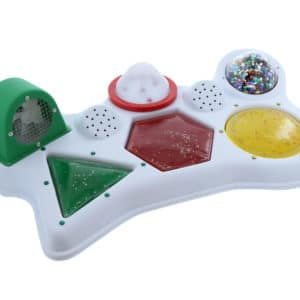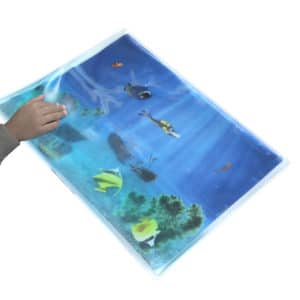Tactile Sensory Toys
Sensory processing differences often appear in individuals diagnosed with Autism Spectrum Disorder (ASD), developmental disabilities or special needs. When a person has sensory processing differences, it’s essential to stimulate the senses to help the brain process information in a meaningful way. With tactile sensory toys from Enabling Devices, these individuals can experience an assortment of textures and touch sensations.
-
 Cosmic Liquid TilesSKU #3852WAmazing liquid floor tiles come in four bright colors that move with every step, jump, dance or hop.$49.95 – $189.95
Cosmic Liquid TilesSKU #3852WAmazing liquid floor tiles come in four bright colors that move with every step, jump, dance or hop.$49.95 – $189.95Select options This product has multiple variants. The options may be chosen on the product page
-
 Fish Play MatSKU #3152Our large, soft gel mat contains six different, colorful fish. Push, poke and prod the sparkly blue gel and fish for a wonderful tactile experience.$118.95
Fish Play MatSKU #3152Our large, soft gel mat contains six different, colorful fish. Push, poke and prod the sparkly blue gel and fish for a wonderful tactile experience.$118.95Add to cart
-
 Gel Pad Activity CenterSKU #3951Three different gel pad switches make this activity center especially appealing. Provides terrific auditory, tactile and visual stimulation.$449.95
Gel Pad Activity CenterSKU #3951Three different gel pad switches make this activity center especially appealing. Provides terrific auditory, tactile and visual stimulation.$449.95Add to cart
-
 Laptop Fish MatSKU #3159Take a trip into the wild blue yonder with our ocean-themed sensory gel pad. Ideal for young and old alike, users will have a swimmingly great time moving four colorful fish across the ocean floor while experiencing tactile and visual sensory fun.$69.95
Laptop Fish MatSKU #3159Take a trip into the wild blue yonder with our ocean-themed sensory gel pad. Ideal for young and old alike, users will have a swimmingly great time moving four colorful fish across the ocean floor while experiencing tactile and visual sensory fun.$69.95Add to cart
-
Textured Marble Fidget BoardSKU #4394Who isn’t attracted to the cool, smooth texture and colorful, visual appeal of marbles that move when you touch them?$179.95
Add to cart
The Benefits of Tactile Sensory Toys
The tactile system provides the brain with information received from our skin receptors. These receptors include vital information such as pain and temperature, as well as discriminatory input such as textures, shapes, sizes and weight. Children gain this information through exploratory play activities and interaction with the world around them.
Touch (tactile) sensory toys for individuals with special needs can facilitate an organized play experience and assist in participation in activities of daily living, such as mealtime activities, tooth brushing, dressing and grooming. With tactile toys, you can:
- Facilitate tactile processing: Certain textures or sensations may cause hypersensitivity, causing the person to avoid tactile exploration. Other individuals may experience “tactile seeking,” craving touch as a means of sensory organization. Tactile toys can foster tactile exploration that meets the individuals’ sensory needs. Children and adults with tactile sensitivity often benefit from deep touch and heavy work, while those with tactile hyposensitivity may seek out fidget toys as a means of sensory organization.
- Improve fine motor skills: Detailed tactile toys can include small manipulatives, sensory bins, vibration, textured switches and toys that engage the user in hand exploration. As users play with these toys, they develop their sensory-motor abilities.
- Support eye-hand coordination: Other tactile toys require larger movements that support gross and fine motor skills and eye-hand coordination.
Types of Tactile Sensory Toys
Tactile experiences include a range of sensations. Different toys will involve different sides of touch, such as:
- Touch: Some tactile toys are light and squishy, while others are firm with minimal give. These experiences support sensory processing. Individuals with tactile hypersensitivity tend to seek deep touch, such as weighted blankets. Children who are tactile seeking tend to benefit from toys that provide various textures to manipulate, such as fidget toys.
- Textures: There are many textures to experience, from wet and dry materials to soft and rough. Toys with varying textures can promote curiosity and meaningful sensory play experiences.
- Pain and temperature: Knowing whether something is hot or cold can affect our response to a stimulus. Tactile toys can play with temperatures to show the differences between the two. Water play, play dough, slime and messy play assist in promoting age/stage appropriate play skills.
How Tactile Stimulation Works
Tactile stimulation teaches our brains about our environment. Sensory information like textures and temperatures can tell us if an object is safe for touching. In a developing brain, tactile stimulation teaches us how to protect ourselves.
Tactile sensitivity often appears with sensory processing disorder or sensory sensitivities. This sensitivity occurs when the brain has a heightened or dampened response to experiences like temperatures and textures.
While these tactile experiences should communicate valuable information, neurodivergent brains may pay too much or too little attention to these sensations.
Positive or negative sensory experiences may pair with emotional meaning, resulting in sensory avoidance or seeking behaviors. Emotional pairing of sensory input can impact a child’s perception of touch as safe or soothing, affecting their perception of the world around them.
Overall, children who are hyper-responsive to sensory input may experience emotional distress that impacts their ability to participate in daily life activities, such as play, learning and activities of daily living.
Our Tactile Sensory Toys
At Enabling Devices, we carry a range of sensory toys to help individuals learn about their environments in a fun and safe way. Our toys include a range of textures, like squishy liquid mats and shiny, reflective balls. We also have many soft, plush toys that encourage touch.
Some of our tactile sensory toys include elements of play, like our bead chains and Gel Pad Activity Center. With our range of toys, you can support the user’s sensory system while developing sensory-motor play activities.
Shop Our Tactile Sensory Toys
Introducing tactile toys to your sensory space can encourage tactile and environmental exploration. These toys can also help individuals feel safe while engaging in novel sensory-motor play activities. At Enabling Devices, we give you the tools you need for your sensory space. Explore our selection of tactile sensory toys for adults and children.


